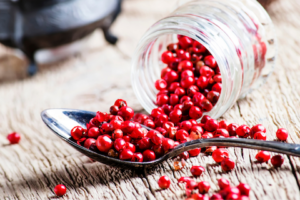Red chili, also known as red pepper or chili pepper, is a popular spice used in cuisines around the world. It comes from the fruit of plants from the Capsicum genus and is known for its fiery and pungent flavor. Here’s what you should know about red chili, including its uses, benefits, and potential side effects:
Uses:
Culinary: Red chili is primarily used as a spice to add heat and flavor to various dishes. It can be used fresh, dried, powdered, or in the form of chili flakes or chili sauce. Red chili is a common ingredient in many cuisines, including Mexican, Indian, Thai, and Chinese.
Here are five common uses of red chili:
- Cooking: Red chili is widely used as a spice in cooking to add heat and flavor to various dishes. It can be used in both fresh and dried forms. It is commonly used in sauces, marinades, curries, stews, stir-fries, and salsas. It adds a spicy kick to dishes and enhances their taste.
- Seasoning: Ground red chili powder or chili flakes are often used as a seasoning to sprinkle over dishes. It can be added to soups, salads, roasted vegetables, grilled meats, and even snacks like popcorn for an extra burst of heat and flavor.
- Pickling: Red chili peppers are used in pickling recipes to add spiciness and flavor. They can be pickled whole or sliced and added to pickling mixtures along with other vegetables or fruits. Pickled red chili peppers are often served as a condiment or used to enhance the flavor of other dishes.
- Sauces and Condiments: Red chili is a key ingredient in various hot sauces, chili pastes, and condiments. These include popular sauces like Tabasco, Sriracha, harissa, and sambal. These sauces can be used as a dip, a topping, or an ingredient to add a spicy kick to dishes.
- Medicinal Purposes: Red chili is used in traditional medicine for its potential health benefits. Capsaicin, the active compound in red chili, is used topically in creams or ointments for its analgesic properties to alleviate muscle pain, arthritis, and neuropathy. It is also used in some nasal sprays for congestion relief.
These are just a few examples of how red chili is commonly used, but its versatility extends to various other culinary applications and even non-food uses, such as in natural insect repellents or pepper sprays.
Also Read: WELLHEALTHORGANIC.COM/KNOW-THE-CAUSES-OF-WHITE-HAIR-AND-EASY-WAYS-TO-PREVENT-IT-NATURALLY
Benefits:
- Rich in nutrients: Red chili is a good source of various vitamins and minerals, including vitamin C, vitamin A, potassium, and iron.
- Pain relief: Capsaicin, the active compound in red chili, has been shown to have pain-relieving properties. It is often used topically in the form of creams or patches for conditions such as arthritis or muscle pain.
- Boosts metabolism: Red chili contains capsaicin, which may help increase metabolism and promote weight loss by temporarily increasing thermogenesis (the process of heat production in the body).
- Heart health: Some studies suggest that regular consumption of red chili may help lower blood pressure and reduce the risk of heart disease.
- Anti-inflammatory properties: Capsaicin has anti-inflammatory effects and may help reduce inflammation in the body.
Side effects:
- Digestive issues: Consuming excessive amounts of red chili can cause digestive discomfort, including stomach pain, heartburn, and diarrhea, especially in individuals with sensitive stomachs or pre-existing digestive conditions.
- Skin irritation: Direct contact with red chili, particularly its seeds or oils, can cause skin irritation or a burning sensation. It is important to wash hands thoroughly after handling chili peppers.
- Allergic reactions: Some individuals may be allergic to red chili, experiencing symptoms such as hives, itching, or difficulty breathing. If you have known allergies to chili peppers, it’s best to avoid them.
- Interaction with medications: Capsaicin supplements or a high intake of red chili may interact with certain medications, such as blood thinners or antihypertensive drugs. Consult with your healthcare provider if you have concerns.
- It’s worth noting that the benefits and side effects can vary depending on the individual and the amount consumed. If you have specific health concerns or conditions, it’s advisable to consult with a healthcare professional before making significant changes to your diet or using chili-based supplements.
Read Also: WELLHEALTHORGANIC.COM:SOME-AMAZING-HEALTH-BENEFITS-OF-DRINKING-WATER-FROM-AN-EARTHEN-POT
Conclusion
In conclusion, red chili is a versatile spice that adds heat, flavor, and aroma to a wide range of dishes. Its uses span across various cuisines and culinary applications, including cooking, seasoning, pickling, sauces, and condiments. Red chili is also used in traditional medicine for its potential health benefits, particularly in topical creams or ointments for pain relief. However, it’s important to be mindful of potential side effects, such as digestive discomfort or skin irritation, especially in individuals with sensitivities or allergies. As with any ingredient, moderation is key, and it’s always advisable to consult with a healthcare professional if you have specific health concerns or are taking medications that may interact with red chili. Enjoy the spicy kick of red chili responsibly and experiment with its flavors in your culinary adventures.
FAQ
Q: Is red chili the same as cayenne pepper?
A: No, red chili and cayenne pepper are not the same. Red chili refers to a variety of peppers, including jalapeno, serrano, and Thai peppers. Cayenne pepper, on the other hand, specifically refers to a type of chili pepper that is typically ground into a fine powder. While they both have a spicy flavor, cayenne pepper tends to be hotter than most varieties of red chili.
Q: How spicy is red chili?
A: The spiciness of red chili can vary depending on the specific variety and its level of maturity. Generally, red chili peppers are known for their heat and can range from mild to extremely spicy. The heat of chili peppers is measured on the Scoville scale, with higher values indicating more spiciness. For example, jalapenos typically range from 2,500 to 8,000 Scoville Heat Units (SHU), while habaneros can range from 100,000 to 350,000 SHU. It’s important to note that individual tolerance to spiciness can vary, so what may be mild for one person could be too spicy for another.
Q: Can red chili help with weight loss?
A: Red chili, specifically its active compound capsaicin, has been studied for its potential effects on metabolism and weight loss. Capsaicin has been found to increase thermogenesis, which can temporarily boost metabolism and calorie burning. Some research suggests that consuming red chili or capsaicin supplements may aid in weight management by promoting fat oxidation and reducing appetite. However, it’s important to note that while red chili may have a modest effect on metabolism, weight loss is a complex process that also requires a balanced diet and regular physical activity.
Q: Are there any health benefits to consuming red chili?
A: Red chili peppers offer several potential health benefits. They are rich in vitamins and minerals, such as vitamin C and vitamin A, which are important for immune function and vision health, respectively. The compound capsaicin found in red chili has shown anti-inflammatory properties and may provide pain relief when used topically. Some studies also suggest that regular consumption of red chili may help lower blood pressure, improve heart health, and provide antioxidant benefits. However, more research is needed to fully understand the extent of these potential benefits and their effects on different individuals.
Q: Can eating red chili cause stomach ulcers?
A: Contrary to popular belief, red chili consumption does not directly cause stomach ulcers. In the past, spicy foods were thought to be a common cause of ulcers, but it is now known that most stomach ulcers are caused by a bacterial infection called Helicobacter pylori or by long-term use of nonsteroidal anti-inflammatory drugs (NSAIDs). However, if you already have a stomach ulcer or a sensitive stomach, consuming excessive amounts of red chili may exacerbate symptoms and cause discomfort. It’s best to listen to your body and consume red chili in moderation if you have any underlying digestive conditions.






















